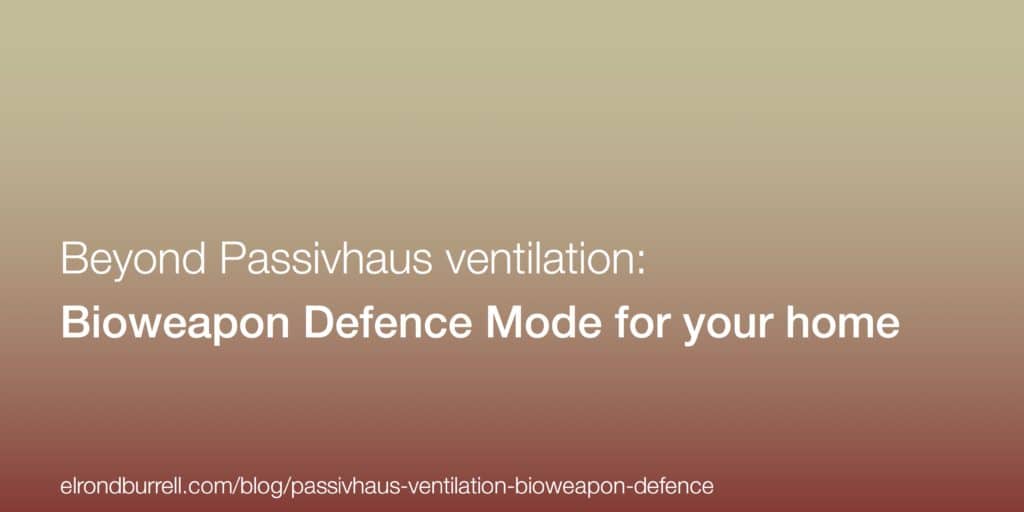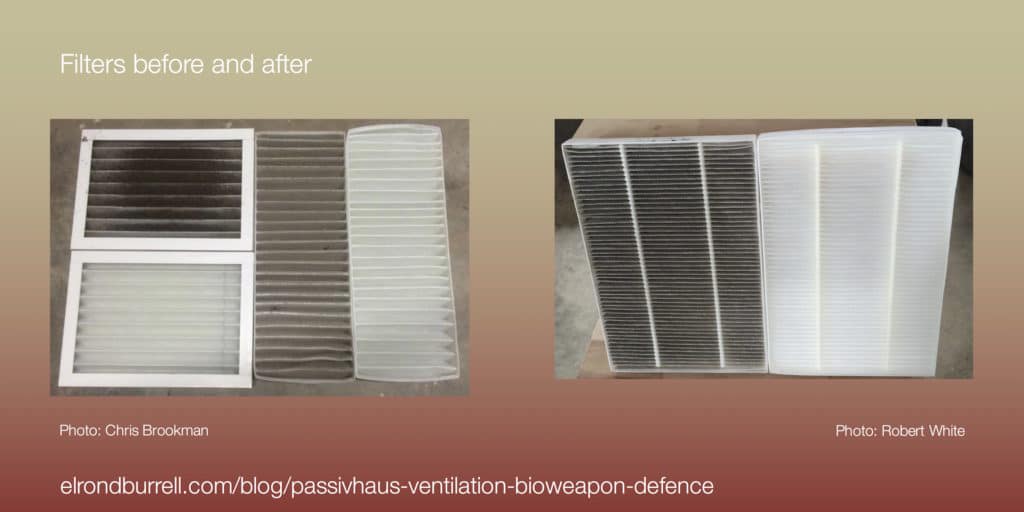In many parts of the world, we take it for granted that we have access to clean air. Or at least we think we do. As we improve the quality of our homes and other buildings, we are starting to get a more realistic picture of what we are breathing in along with our supposed clean air.
Air pollution has a significant and pervasive impact on public health. According to the World Health Organization, it is now considered “the world’s largest single environmental health risk,” with more than three million people dying every year as a result. This is more than twice the number of people that die in vehicle accidents each year.
Is your ‘clean air’ really clean and healthy?

Passivhaus protection against air pollution
In urban environments, there is air pollution from infrastructure, buildings and vehicles burning fossil fuels, and from dust. In rural environments, there is often air pollution from solid fuels being burnt and from pollen. Air pollution from agricultural sprays, radioactive fallout, and dust from fertilisers and mining operations can affect both environments.
And then there is indoor air pollution from materials, finishes, fittings, appliances, heating systems and cooking.
Health and safety are important to Passivhaus. Just as a Passivhaus protects the occupants from thermal discomfort, draughts, condensation and mould, it also protects them against the statistically more relevant hazard of air pollution. Inspired by the air filtration systems used in hospitals, clean rooms, and the space industry, Passivhaus ventilation technology has developed a HEPA filtration system capable of stripping the outside air of pollen, bacteria, and pollution before they enter the house and systematically scrubbing the air inside the house to eliminate any trace of these particles. The end result is a filtration system hundreds of times more efficient than standard ventilation systems, capable of providing the homeowner and occupants with the best possible indoor air quality no matter what is happening in the environment around them.
Passivhaus filters put to the test
The air filtration system was put to the test in real-world environments from Californian suburbs neighbouring freeways, to smelly marshes, landfills, and cow pastures in the central valley of California, to major cities in China. The testing needed to ensure that it captured fine particulate matter and gaseous pollutants, as well as bacteria, viruses, pollen and mould spores.

It was decided to take things a step further and test the complete system in an environment where atmospheric conditions could be precisely controlled and carefully monitored. A single-family Passivhaus home was placed in a small biome contaminated with extreme levels of pollution (1,000 µg/m3 of PM2.5 vs. the EPA’s “good” air quality index limit of 12 µg/m3). The windows and doors were then closed and Bioweapon Defence Mode activated.
Bioweapon Defence Mode
The graph below shows the subsequent evolution in pollution levels inside the house and outside the house in the biome. In less than two minutes, the HEPA filtration system had scrubbed the air in the Passivhaus, bringing pollution levels from an extremely dangerous 1,000 µg/m3 to levels so low as to be undetectable (below the noise floor) by the instruments, allowing the test scientists to remove their gas masks and breathe fresh air while sitting inside a biome full of pollution.

Not only did the ventilation system completely scrub the indoor air, but in the ensuing minutes, it began to vacuum the air outside the house as well, reducing PM2.5 levels by 40%. In other words, Bioweapon Defence Mode is not a marketing statement, it is real. You can literally survive a military grade bio-attack by staying in your Passivhaus home.
Moreover, it will also clean the air outside your home, making things better for those around you.
Bioweapon Defence Mode = Tesla. Not Passivhaus!
Yes, you read that correct. Passivhaus Bioweapon Defence Mode for your home is a work of my imagination. When a friend sent me the Tesla Motor blog post and asked if Passivhaus ventilation systems include a HEPA filter it caught my imagination. (Thanks, Benjamin!)
The text is mostly adapted from the blog post by Tesla Motors. Bioweapon Defence Mode is a reality for a Tesla Model X and the upcoming Model S. But, wouldn’t it be nice for a state-of-the-art Passivhaus home, too?
The before and after photos of Passivhaus ventilation system filters come from Chris Brookman who lives in Silverton Passive House and Robert White who lives in a Passivhaus home in Herefordshire.
Passivhaus ventilation systems have G4 and F7 filters which are not as fine as a HEPA filter. It would be possible to design a passivhaus ventilation system to incorporate a HEPA filter, though. And maybe this will happen.
Do you drive a Tesla? Maybe you should live in a Passivhaus home.
Even without a Bioweapon Defence Mode, the ventilation system in a Passivhaus home does filter incoming ‘fresh’ air and remove indoor pollution.
- Also featured on Renewables International: Like Tesla? You’ll love Passive House.
Spread the word: please send this article to your friends and colleagues and share it on your favourite social media channel.
Enter your email at this link to subscribe. You’ll be notified of each new post and receive exclusive Passivhaus insights (not published on the blog) direct to your inbox.
Hahaha! You got me there. As I was reading this, having read the Tesla article, I kept thinking, “this is a copy of that Tesla article!”. It would be really nice to have this level of filtration in homes.
Great article and narrative! For outgoing air, G3 is required for Passive House, but this will not make much of a difference. It’s already easy to go one up with filtration with most ventilation systems now – but here’s the rub: the finer your filter, the more power you need to push air through them. F7, which is the requirement for Passive House, filters out about 95% of the nasty stuff, PM2.5, which is pretty cool, nearly all pollen, and most mould spores. Going HEPA could eliminate PM2.5, and almost all fungi/bacteria, but your fans would need to work quite a bit harder and less efficiently. My advice would therefore be: go with F7 for typical situations, but have a HEPA filter ready in case of the Zombie apocalypse or certain outcomes of the US presidential elections. It might come in handy, then.
The irony of driving a car and being that concerned with air pollution!
Electric car = no pollution, though?
Sorry, I cannot follow you guys anymore… Did we not learn, just last week, was it from WHO, that our too much clean environments, is the main cause of these severe allergies we are seeing?
I am not advocating for our pollution – because diesel smoke and other things are also causes of the same – and causes of respiratory diseases causing the 3 million annual deaths. However – the pollen allergies etc., – these are – apparently – caused by total intolerance towards the natural dusts – caused by our too clean homes, where babies cannot eat a lump of soil (anymore) and cannot bolter themselves in dust and dirt on the floors, as these now are hermetically cleaned.
I cannot follow all this opposite opposite opposite information. What is the truth? Or are you just writing to write yet an opposition article? 🙂
[…] Reposted with kind permission. (Craig Morris / @PPchef) […]